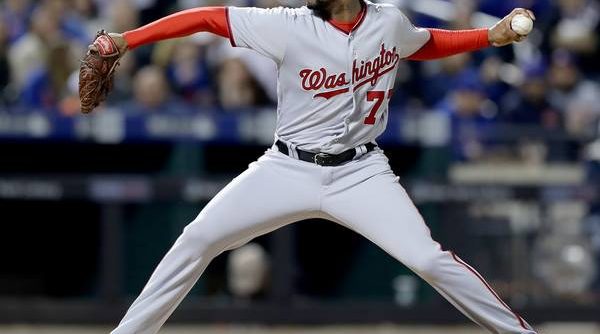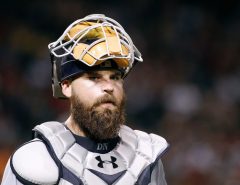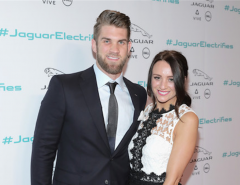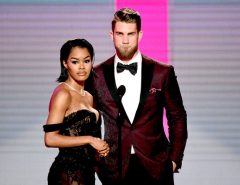As their bats have struggled to warm up in the early going, the Nationals have been buoyed by their pitching. A team ERA of 2.88, the second best in baseball behind the Cubs, has lifted the Nats to first place in the NL East (though that lead sits at just a half game after Monday’s loss to the Mets).
In a surprising show of equity, both the relievers and starters rank second in ERA. But it is the relief corps that has stolen the show recently. Since May 9th, the bullpen has ceded just two runs in 36 1/3 innings, good for a 0.50 ERA. And after four scoreless in relief of Gio Gonzalez tonight, it has not allowed a run in the past eight games, an impressive 23 1/3-inning streak that is approaching the equivalent of three consecutive shutouts. During that span, the relievers have allowed 16 hits and walked seven while striking out 26.
Obviously, such a feat is a collective effort, but let’s look at each of the individual pitchers and see what their contribution to the whole has been. Below, I’ll list each of the seven pitchers and their May statline.
Felipe Rivero: 7 1/3 IP, 8 H, 5 ER, 2 BB (and 3 HBP), 10 K
Often referred to as a future closer, Rivero’s May has been rocky, as indicated by his team-worst 6.14 ERA. His full-season 4.50 ERA is also less than impressive. But Rivero’s underlying numbers tell a different story: his strikeouts have jumped by nearly three per nine innings (from 8.01 to 10.80) while his walks have increased by an insignificant 0.2 per nine. The trouble for Rivero can be boiled down to his abnormally low 67.6% strand rate and his 0.90 HR/9 rate. Strand rate is often considered a function of luck, with most all relievers hanging around 75%. With any luck, that should be on the rise, putting his ERA on a corresponding fall. And while a 0.90 HR/9 rate may seem low, it needs a bit of context. Rivero allows very few fly balls — just 28% of his batted balls this season — so it requires an abnormally high home run per fly ball rate to get a HR/9 as high as his. His HR/FB rate this year is 14.5%, more than three times his 4.5% rate last year. While 4.5% is probably too low to hope for, Rivero’s rate should be on its way down. His surface numbers aren’t as pretty as usual, but there’s a strong case to be made that he’s pitching even better than he did in his stellar 2015.
Yusmeiro Petit: 11.2 IP, 9 H, 0 ER, 1 BB, 8 K
Petit has been a godsend for the Nationals’ bullpen. Without Craig Stammen last year, they lacked a reliable long man and pitchers struggled to settle into roles. But Petit has yet to allow a run in May and has just a 1.52 ERA on the season, often delivering long outings to save the rest of the bullpen or keep the Nats in an extra-inning game. His 3.20 FIP confirms the obvious: that his current ERA is unsustainable (just see his 93.8% strand rate!) but he has been an excellent stabilizing force in the middle of this bullpen.
Shawn Kelley: 7 IP, 4 H, 0 ER, 1 BB, 10 K
What can be said about Shawn Kelley that hasn’t already been said about Mariano Rivera? I’m kidding, but it’s hard to overstate how incredible Kelley has been. He remains deadlocked with Fernando Rodney as the only two relievers with at least 15 innings to not allow a run, though Baltimore’s Vance Worley is not far behind. The difference between Kelley and Rodney (and Worley) is that Kelley’s numbers back it up. I said Petit’s 1.52 ERA was unsustainable, but Kelley’s 0.67 FIP — the lowest in baseball — makes you think anything is possible. His 12.6 K/9 and 1.2 BB/9 are both elite (and career bests), and only the Yankees’ Andrew Miller has him beat in both categories. After his fastball was down two MPH from last season in the spring and even into April, it has rebounded in May to his career mark. For a pitcher who had to pitch in spring minor league games, Kelley has come a long way to start better than any reliever in baseball.
Jonathan Papelbon: 7.1 IP, 8 H, 3 ER, 4 BB, 6 K
Papelbon has not quite been the closer most hoped for. His 3.06 ERA is acceptable, but that and his 3.18 FIP are built on some excellent home run luck. His HR/FB rate of 4.2% is just over a third of his 11.3% rate last year, indicating he could be in for some regression (though he maintained a 2.7% HR/FB rate for all of 2014). His other peripherals are also discouraging: he’s lost 1.36 strikeouts per nine and gained 0.84 walks per nine from last years, and his strikeout rate is almost 3 ½ per nine lower than his career mark of 10.04. His ground ball rate is also down significantly, from 49.7% last year to 33.3%. Perhaps most damningly, his swinging strike rate is down to 9.4% from 12.4% last year (Kelley is second at 19.4%, and Rivero is 11th, just ahead of Craig Kimbrel!). In more familiar terms, he has fallen from David Robertson to Cory Gearrin. It’s still early, and I don’t want to prematurely pronounce him dead, but I’m glad his contract is up after this season.
Blake Treinen: 12.2 IP, 10 H, 4 ER, 4 BB, 14 K
Treinen has improved since walking five batters in seven April innings, and it seems the arrow is pointing up for him across the board. The strikeouts are there and the walks have recently been limited, but his peripherals are mixed. His 23.1% HR/FB rate screams out for regression, but so does his 85.9% strand rate. If Treinen’s true talent is somewhere around his 3.57 ERA, he can certainly find a role as a middle reliever for this team. He’ll never inspire confidence when he enters the game though.
Oliver Perez: 6 IP, 4 H, 2 ER, 2 BB, 5 K
Perez has been basically as expected: lots of strikeouts (11.25 per nine) and lots of walks (4.5 per nine). The total package is a solid reliever you can trust to face a tough lefty or the occasional righty. His FIP is lower than his 3.00 ERA because he has yet to give up a home run, but this is about the level I expect for his the rest of the year.
Sammy Solis: 10.2 IP, 4 H, 2 ER, 6 BB, 10 K
Solis has been serviceable in place of Matt Belisle. The walks are alarming, but his walk numbers have been good enough in the minors (2.4 per nine career), and he walked just 1.7 per nine in 21 1/3 MLB innings last year. With his stuff as a lefty, it’s not hard to see him being a good part of a major league bullpen soon.





Leave a Reply